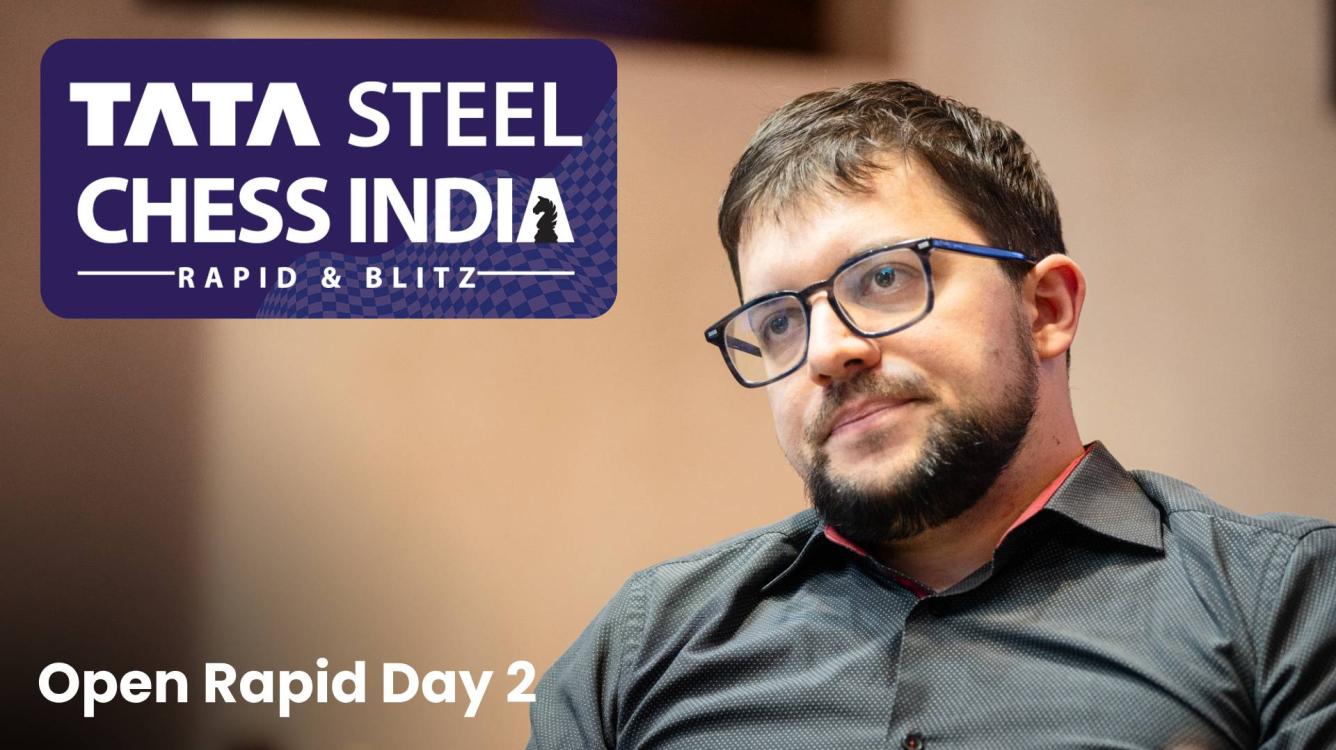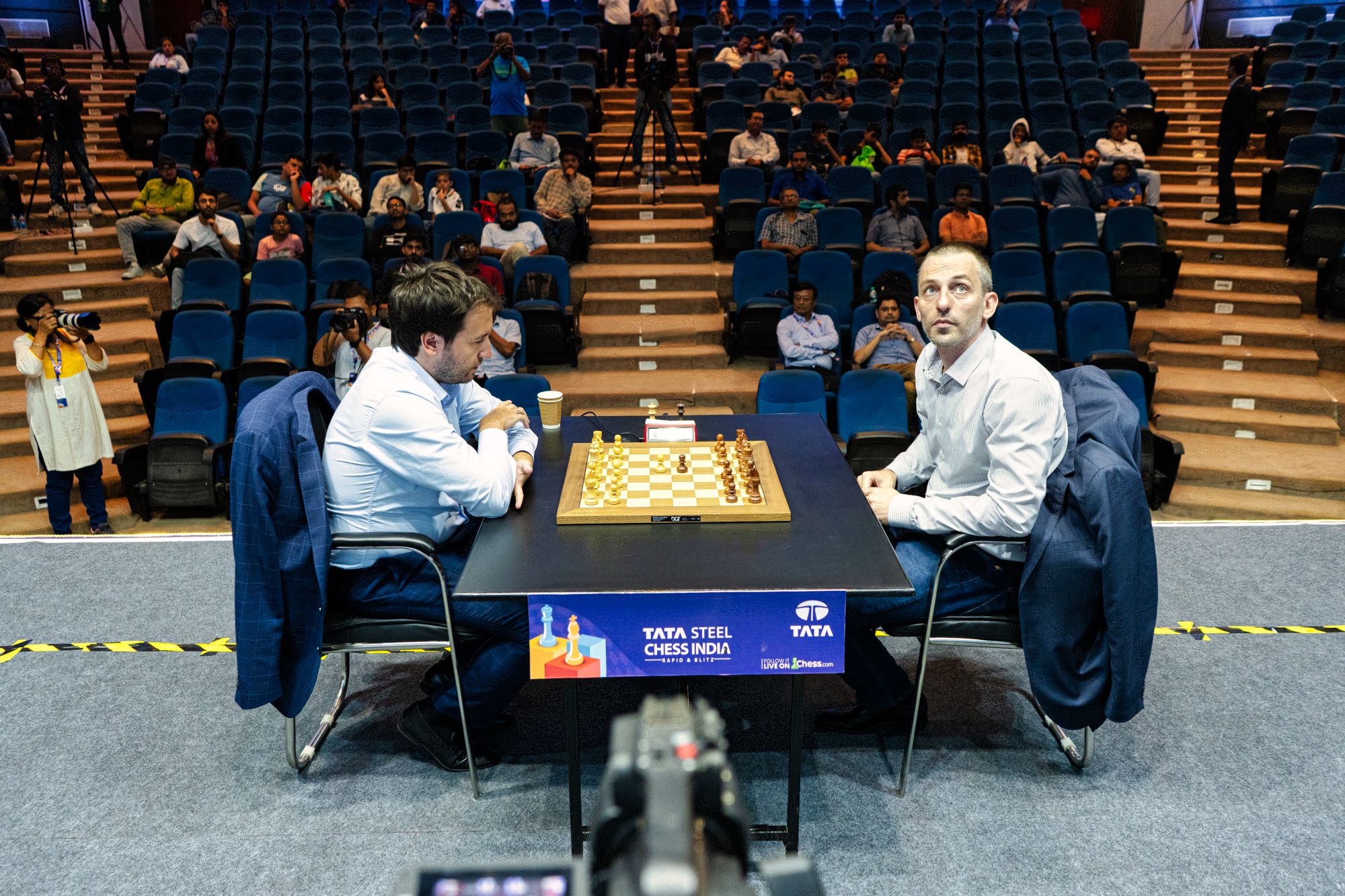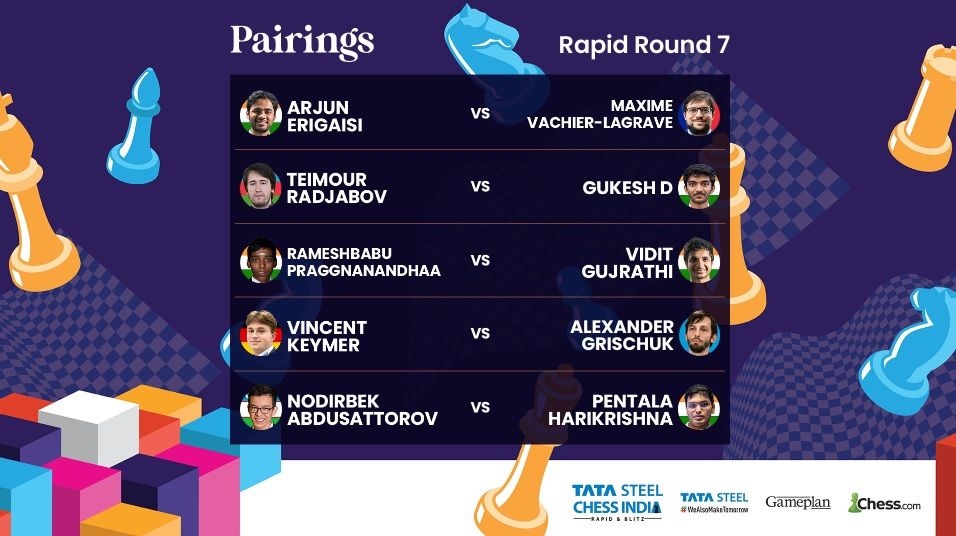
Vachier-Lagrave Sole Leader Courtesy Of King And Knights
GM Maxime Vachier-Lagrave played imaginatively to surge into the sole lead with 4.5 out of six points at the end of the second day of the 2023 Tata Steel Chess India Open Rapid. GM Teimour Radjabov was in the lead until he was outplayed by GM Vidit Santosh Gujrathi in the final game of the day, enabling Vachier-Lagrave to take over. Radjabov remains in second place on four points.
Below the two leaders is a group of four players on three points: GMs Praggnanandhaa Rameshbabu, Vidit, Alexander Grischuk, and Dommaraju Gukesh.
Intense fights were the order of the day, resulting in tightly-packed standings, with all the players entering into the final day with a theoretical chance of winning the title.
The Open Rapid tournament continues on September 7 at 5:30 a.m. ET / 11:30 CEST / 15:00 IST.
How to watch the Tata Steel India Chess Open Rapid & Blitz
You can watch the event live on Twitch, as well as our YouTube channels for Chess.com and Chess24. Keep up to date with all the details of the tournament on our live events platform, and follow the games by clicking here.
The broadcast was hosted by GM Robert Hess and IM Tania Sachdev.
- Vachier-Lagrave's Delightful Play
- More Knights In Action
- Opening Explorations
- Delights And Tragedies
Vachier-Lagrave's Delightful Play
Vachier-Lagrave produced a sacrificial positional masterpiece against GM Vincent Keymer in the very first game of the day, with his knight maneuver resembling the classic Petrosian-Reshevsky from Lugano 1968. He showed a remarkable feel for the king in the queenless middlegame.
Here, emphasizing the inherent weakness of Black's pawns, he uncorked 23.Ng1! 24.Nh3! and 25.Nf4!, dominating the board.
The icing on the cake came with the delightful exchange sacrifice 31.Rdxd4!, thus beginning the conversion of the advantage in the endgame.
This aesthetic masterpiece is our Game Of The Day, annotated by GM Rafael Leitao.
When I reminded Vachier-Lagrave of the Petrosian classic after the game, he was obviously delighted: "This is something that, you know, players like me who have not spent their entire lives on the computer to work on chess, can spot. Especially this Ng1 maneuver, I saw that preventing 24.Nh3 with 23...Bg2 was the right move there, for Vincent".
Did he plan the exchange sacrifice in advance? "This exchange sacrifice came naturally! I knew it was an option. I had no idea that it was actually winning. I thought there were so many weaknesses in Vincent's pawns, I should be pressing, and I made it."
The previous day, he had a crazy (tactical) game against Vidit. Today he played solidly. Why the change of approach? He smiles and replies: "It was not my plan to get such a crazy game against Vidit. It happens in the Bg5 Najdorf—things can get crazy. It was out of book early for both sides quite quickly..."
His third-round victory over GM Nodirbek Abdusattorov, showed his remarkable feel for his king, again.
Vachier-Lagrave went 23.Kf2 first, and followed up with 30.Kg3, with queens still on the board—-subtle and beautiful to watch. How did he hit on these moves over the board? Vachier-Lagrave insists he had logical reasons to do so: "Oh yeah, Kf2 is natural to cover the f3 and g2 squares all the time. At the same time, my rooks can come to the h-file at some point." Delightful insights.
GM Pentala Harikrishna's game against Radjabov from the fourth round also featured remarkable knight maneuvers.
Sensing the need to mobilize his forces on the kingside, Harikrishna maneuvered his knight with 19.Ne2, 20.Ng3, and 22.Nf5, pressurizing his opponent. Later, when the focus of play shifted to the queenside, he rerouted the knight again.
Unable to make headway on the kingside, Harikrishna decided to send his knight to the queenside with 24.Ng3, 27.Nf1, 28.Nd2, and 29.Nb3, from where it established control of the c5-square, giving a slight advantage. However, the game became error-prone in the final minute of play, with Radjabov managing to win.
In the fifth round, Harikrishna showed his creative side with more knight maneuvers in the opening phase against the young Praggnanandhaa.
Harikrishna unleashed a series of undecipherable knight maneuvers with 7...Na5, 8...Nc6, 9...Nb4, 11...Nc6, after which an original position was reached in the middlegame. The game resulted in a win for Harikrishna.
Harikrishna's knight adventure in the opening was not an isolated happening of the day—there were many more delightful creative examples.
It's established practice at the top levels when playing quicker time controls to have a special opening repertoire, which gets unleashed in rapid, blitz, and bullet games. Unlike in classical chess, one can try a creative idea even if not fundamentally sound, or frowned upon by chess engines, with the faith that the opponent won't be able to react correctly in the limited time available. Thus, the range of openings employed by the young generation of players has broadened significantly.
In live commentary, GM Viswanathan Anand zeroed in on the advent of chess engines as the reason for this development. "The range of moves they consider is much broader. Computers showed everyone there are many more moves possible. It's hard to believe what opening theory once looked like—it was very, very narrow. You thought there were two first moves. Now there are 10 moves in that position!"
For spectators, spotting unusual moves in the openings in rapid chess is an interesting pursuit, and the second day had its moments too.
GM Arjun Erigaisi is well-known for his opening experiments in quick time controls, and he unleashed one against Grischuk in the fourth round.
The sequence of 1.d4 Nf6 2.c4 b6 3.Nf3 Bb7 4.g3 Bxf3?! looked unorthodox, to say the least.
In a regular Samisch variation of the Nimzo-Indian Defense, Praggnanandhaa's 8...h6 was unorthodox, and Grischuk responded with the aggressive 9.h4, after which the position turned wild. The game ended in a draw after 66 moves.
Gukesh seemed to give Arjun a taste of his own medicine with 3.b3 in a regular Sicilian Defense. The game ended in a draw on move 41, after even play.
Abdusattorov's 2...g6 is unorthodox, but at least it has a name—the Hyper-Accelerated Dragon. It is the game we analyzed above.
After his eventful loss against Vachier-Lagrave the previous day, Vidit came up with an improved performance. His sixth-round game against sole leader Radjabov had a bold onslaught on the kingside.
Mainly being a strategic player in yesteryears, Vidit's play has been aggressive in most of his games in Kolkata. Has this been his strategy?
"Not just for this tournament. In general, I feel my play is changing a bit, over the last year. Probably in the World Cup and here, it is more visible than before. It was a gradual change. I am playing with less inhibitions."
In a chat with IM Daniel Rensch during the 2023 Pro Chess League, Vidit had proclaimed "This is Vidit 2.0". Has this been a conscious decision, and why?
"It was a conscious decision. Probably because I stagnated for a while. I had to mix things up. I wanted to try out a couple of things to see what works. So, this is just one of those things. ...It is basically adding a new layer to my play."
Did he train in any specific way to become more aggressive?
"Not really. ...I was struggling in a particular type of position, which I tried to do targeted training for. But mostly it has been a lot of psychological training—not chess. A lot of people contributed to this. Sports psychologists, coaches, and even the family have played a big role in this. The change was so subtle that it was hard to observe. Now it is obvious, but over the period of a year it was not obvious—it is a gradual change".

Continuing with our topic on knight sorties, Radjabov's knight maneuvers were not able to halt Grischuk's onslaught on the kingside. His position seemed to get worse slowly before Grischuk suffered a remarkable blind spot.
Alexander Grischuk blunders his queen in a winning position against the leader Teimour Radjabov!https://t.co/Wz0ffuWpiJ #TataSteelChessIndia pic.twitter.com/leZULvFBm5
— chess24.com (@chess24com) September 6, 2023

Grischuk himself had benefited from an oversight by Arjun in the fourth round.
After a difficult first day, Harikrishna seemed to be in better shape on the second day, and achieved a winning position in his sixth-round game against Keymer. However, he inadvertently allowed a three-fold repetition of the position.
White has to watch out for checks from the black knight, and he has a win after 83.Kg1! Rg3+ 84.Kg2!, as 84...Rf3+ is not possible because of the beautiful 85.Qxf3!! gxf3 86.a6!! and the a-pawn is unstoppable. Instead, he ended up repeating the position for the third time, allowing Keymer to claim a draw.

All Games: Open Rapid Day 2
Open Rapid Standings After Round 6

The Tata Steel Chess India Open Rapid concludes on Thursday with rounds seven to nine.
Open Rapid Pairings Round 7

The 2023 Tata Steel Chess India Men's and Women's Rapid and Blitz are two of India's most prestigious rapid chess events. The Women's event takes place before the Men's. Players compete in a 10-player round-robin in three days of rapid games with a 25+10 time control, followed by two days of blitz games played at a 3+2 time control.
Previous Coverage
- Day 6: Four-Way Tie At Top After Combative 1st Day
- Day 5: Ju Wenjun Wins Dramatic Four-Horse Race To Secure Blitz Title
- Day 4: Harika, Ju Lead After Tumultuous Day
- Day 3: Divya Winner After Nerve-Wracking Finale
- Day 2: Divya Deshmukh's Dazzling Day
- Day 1: Deshmukh, Agrawal Leading With Power Play
- Inauguration: Star Players Kick Off Tata Steel Chess India


